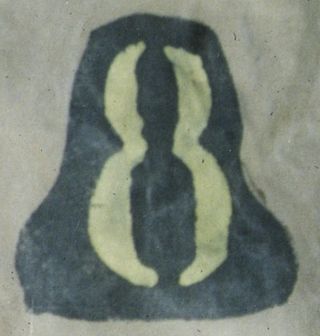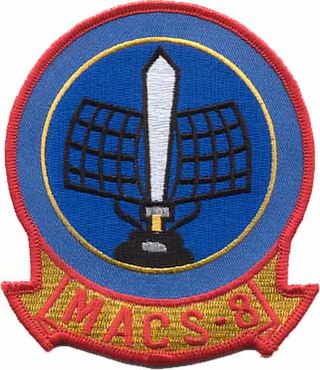
Marine Aircraft Group 32 (MAG-32) was a United States Marine Corps aviation unit established during World War II.

Marine Air Control Squadron 1 (MACS-1) is a United States Marine Corps aviation command and control squadron. The squadron provides aerial surveillance, air traffic control, ground-controlled intercept, and aviation data-link connectivity for the I Marine Expeditionary Force. It was the first air warning squadron commissioned as part of the Marine Corps' new air warning program and is the second oldest aviation command and control unit in the Marine Corps. The squadron is based at Marine Corps Air Station Yuma and falls under Marine Air Control Group 38 and the 3rd Marine Aircraft Wing.

Marine Air Control Group 28 (MACG-28) is a United States Marine Corps aviation command and control unit based at Marine Corps Air Station Cherry Point that is currently composed of four command and control squadrons and a low altitude air defense battalion that provide the 2nd Marine Aircraft Wing with airspace coordination, air control, immediate air support, fires integration, air traffic control (ATC), radar surveillance, aviation combat element (ACE) communications support, and an integrated ACE command post in support of the II Marine Expeditionary Force.

Marine Air Control Squadron 4 (MACS-4) is a United States Marine Corps aviation command and control squadron that provides aerial surveillance, Ground-controlled interception, and air traffic control for the III Marine Expeditionary Force. Originally formed in World War II, the squadron's most notable combat operations occurred during the Vietnam War when it was the first unit to ever use the Marine Tactical Data System. They are currently based at Marine Corps Air Station Futenma and fall under the command of Marine Air Control Group 18 and the 1st Marine Aircraft Wing.

Marine Air Control Squadron 2 (MACS-2) is a United States Marine Corps aviation command and control squadron. The squadron provides aerial surveillance, Ground-controlled interception, and air traffic control for the II Marine Expeditionary Force. They are based at Marine Corps Air Station Cherry Point and fall under Marine Air Control Group 28 and the 2nd Marine Aircraft Wing.

Marine Air Control Squadron 5 (MACS-5) was a United States Marine Corps aviation command and control squadron. The squadron provided aerial surveillance and early warning while it was active from 1944 through 1993. They were last based at Marine Corps Air Station Beaufort, South Carolina and fell under the command of Marine Air Control Group 28 (MACG-28) and the 2nd Marine Aircraft Wing.

Marine Air Control Squadron 7 (MACS-7) was a United States Marine Corps aviation command and control squadron. The squadron provided aerial surveillance and ground-controlled interception and saw action most notably during the Battle of Okinawa in World War II and the Vietnam War. They were last based at Marine Corps Air Station Yuma and fell under the command of Marine Air Control Group 38 (MACG-38) and the 3rd Marine Aircraft Wing.
Air Warning Squadron 2 (AWS-2) was a United States Marine Corps aviation command and control squadron during World War II. The squadron was tasked to provide aerial surveillance and early warning during amphibious assaults. They took part in the Battle of Guam in 1944 and would eventually move to Peleliu in 1945 assuming responsibility for air defense in that sector until the end of the war. The squadron departed Peleliu for the United States in January 1946 and was quickly decommissioned upon its arrival in California. To date, no other Marine Corps squadron has carried the lineage and honors of AWS-2 to include Marine Air Control Squadron 2 (MACS-2).

Air Warning Squadron 8 (AWS-8) was a United States Marine Corps aviation command and control unit that provided aerial surveillance and early warning of enemy aircraft during World War II. The squadron was commissioned on 3 March 1944 and was one of five Marine Air Warning Squadrons that provided land based radar coverage during the Battle of Okinawa in 1945. AWS-8, utilizing the callsign "Arsenic," remained on Okinawa as part of the garrison force following the Surrender of Japan. The squadron departed Okinawa for the United States in February 1946 and was quickly decommissioned upon its arrival in California. To date, no other Marine Corps squadron has carried the lineage and honors of AWS-8 to include Marine Air Control Squadron 8 (MACS-8).
Air Warning Squadron 6 (AWS-6) was a United States Marine Corps aviation command and control unit that provided aerial surveillance and early warning of enemy aircraft during World War II. The squadron was activated on 1 January 1944 and was one of five Marine Air Warning Squadrons that provided land based radar coverage during the Battle of Okinawa in 1945. AWS-6 remained on Okinawa as part of the garrison force following the Surrender of Japan. The squadron departed Okinawa for the United States in February 1946 and was quickly decommissioned upon its arrival in California. To date, no other Marine Corps squadron has carried the lineage and honors of AWS-6 to include Marine Air Control Squadron 6 (MACS-6).

Marine Air Control Squadron 8 (MACS-8) was a United States Marine Corps aviation command and control squadron. The squadron provided aerial surveillance and ground-controlled interception (GCI). Originally formed in World War II as Air Warning Squadron 18 (AWS-18), the squadron served as a training and replacement unit until it was decommissioned in April 1947 as part of the post war drawdown of forces. Reactivated in 1952 during the Korean War the squadron took part in numerous Far East deployments during the 1960s. Transferred to Japan in 1969, the squadron was decommissioned in 1971 as the last Marine Corps units were departing South Vietnam. They were last based at Marine Corps Air Station Futenma, Okinawa, Japan and fell under the command of Marine Air Control Group 18 (MACG-18) and the 1st Marine Aircraft Wing.

Marine Air Control Squadron 3 (MACS-3) was a former United States Marine Corps aviation command and control squadron. During its later years it also served as an operational test and evaluation squadron. Originally formed in World War II as Air Warning Squadron 12 (AWS-12), its original mission was to provide aerial surveillance and ground-controlled interception (GCI) for Marine Corps forces during amphibious operations. The squadron did not participate in combat operations during WWII however it did deploy and operate during the Korean War. In 1961, MACS-3 was transferred from the Fleet Marine Force to the administrative control of Air, Fleet Marine Forces Pacific in order to serve as the operational test and evaluation squadron for what was at the time, the largest research and development project in the Marine Corps - Marine Tactical Data System (MTDS). After MTDS testing was complete the Marine Corps recognized that it was not properly staffed to develop, test, and acquire new digital equipment. On 1 July 1970, MACS-3 was decommissioned and its structure and equipment were utilized to form Marine Corps Tactical Systems Support Activity (MCTSSA) at Marine Corps Base Camp Pendleton, California. Of note, MCTSSA does not carry MACS-3's lineage and honors.
Air Warning Squadron 3 (AWS-3) was a United States Marine Corps aviation command and control squadron during World War II. The squadron's primary mission was to provide aerial surveillance and early warning of approaching enemy aircraft during amphibious assaults. The squadron participated in the Philippines campaign (1944–1945) in support of the Eighth Army on Mindanao. AWS-3 was decommissioned shortly after the war in October 1945 at Marine Corps Air Station Miramar, California. To date, no other Marine Corps squadron has carried the lineage and honors of AWS-3 to include the former Marine Air Control Squadron 3 (MACS-3).
Assault Air Warning Squadrons were United States Marine Corps aviation command and control units formed during World War II to provide early warning, aerial surveillance, and ground controlled interception during the early phases of amphibious landing. These squadrons were supposed to be fielded lightweight radars and control center gear in order to operate for a limited duration at the beginning of any operation until larger air warning squadrons came ashore. Four of these squadrons were commissioned during the war with one, AWS(AT)-5, taking part in the Battle of Saipan. All four squadrons were decommissioned on 10 November 1944 because the Marine Corps was unable to field the required mobile radars. The "first in" capability that the Assault Air Warning Squadrons were supposed to provide was transferred to the Early Warning Teams that were added to the tables of organization for the regular air warning squadrons.
Air Warning Squadron 4 (AWS-4) was a United States Marine Corps aviation command and control squadron during World War II. The squadron's primary mission was to provide aerial surveillance and early warning of approaching enemy aircraft during amphibious assaults. The squadron participated in the Philippines campaign (1944–1945) in support of the Eighth Army on Mindanao. AWS-4 was decommissioned shortly after the war in October 1945. To date, no other Marine Corps squadron has carried the lineage and honors of AWS-4 to include Marine Air Control Squadron 4 (MACS-4).
Air Warning Squadron 9 (AWS-9) was a United States Marine Corps aviation command and control squadron during World War II. The squadron's primary mission was to provide aerial surveillance and early warning of approaching enemy aircraft during amphibious assaults. Formed in April 1944, the squadron did not deploy overseas until after the end of the war. It arrived in Tokyo Bay to take part in the occupation of Japan only to find out it was not required. The squadron returned to the U.S. and was decommissioned shortly after in December 1945. To date, no other Marine Corps squadron has carried the lineage and honors of AWS-9 to include the former Marine Air Control Squadron 9 (MACS-9).

The VMF(N)-531 GCI Detachment was a short-lived aviation command and control unit that was part of the United States Marine Corps's first night fighter squadron, VMF(N)-531. This detachment was the Marine Corps' first dedicated GCI detachment utilized in a combat zone. In the early phases of World War II the Marine Corps did not have stand-alone early warning and ground-controlled intercept (GCI) units so these capabilities were initially placed in the headquarters of each Marine Aircraft Group and with individual night fighter squadrons. The detachment was deployed in the South Pacific from August 1943 through August 1944 and was responsible for the interception of numerous Japanese aircraft. Lessons learned from this deployment were instrumental in establishing tactics and procedures for the Marine Corps' newly established Air Warning Program. Upon returning from its first and only deployment, the detachment was dissolved and its members went on to serve as instructors at the 1st Marine Air Warning Group, which was responsible for training new squadrons. Many of them later served in leadership roles in these Air Warning Squadrons as they supported follow on combat operations.

Marine Night Fighter Squadron 532 was a United States Marine Corps night fighter squadron that was commissioned during World War II. The squadron, which flew the F4U-2 Corsair, was the second night fighter squadron commissioned by the Marine Corps, the first to fly a single-seat, radar-equipped night fighter, and the only Marine squadron to fly the F4U-2 in combat. VMF(N)-532 saw extensive combat operations throughout 1944 in support of Marine Corps operations at Kwajalein Atoll and the Mariana Islands. The squadron was decommissioned on 31 May 1947, as part of the post-war draw down of the service. Since then, no other Marine Corps squadron has carried the lineage and honors of VMF(N)-532.












